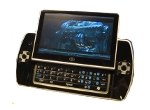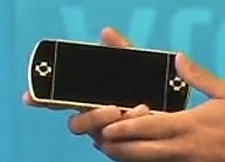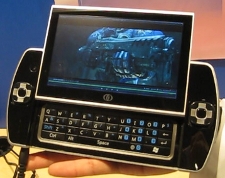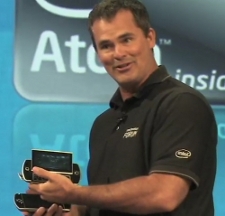Web-centric gaming handheld runs Windows 7 on Oak Trail
Last updated Sep 15, 2010 — 651 views Ocosmos unveiled a pocket-sized, multifunction, multimedia handheld running Windows 7 at an Intel Developer Forum keynote Tuesday in San Francisco. Among the first demonstrated handhelds to incorporate Intel’s new “Oak Trail” SoC (system-on-chip processor), the OCS1 boasts a 4.8-inch touch-screen, slide-out keyboard, WiFi, 3G, GPS, speaker, camera, web browsing, and PC-compatible peer-to-peer gaming.
Ocosmos unveiled a pocket-sized, multifunction, multimedia handheld running Windows 7 at an Intel Developer Forum keynote Tuesday in San Francisco. Among the first demonstrated handhelds to incorporate Intel’s new “Oak Trail” SoC (system-on-chip processor), the OCS1 boasts a 4.8-inch touch-screen, slide-out keyboard, WiFi, 3G, GPS, speaker, camera, web browsing, and PC-compatible peer-to-peer gaming.


The OCS1 has a slide-out keyboard
(click images to enlarge)
Intel showcased the OCS1 at its Tuesday IDF keynote, touting it as one of the first operational handhelds — and the first gaming console — to be based on its new Atom-based Oak Trail SoC.
Since the device is web- and 3G-enabled but does not provide cellular phone features, the OCS1 may be said to belong to the UMPC (ultra-mobile PC) product category, which lately has been eclipsed by smartphones, such as the iPhone and its Android-based competitors.
About Oak Trail
The Oak Trail platform is the newest entry in Intel’s new Atom-based SoC line. Intel says the platform is “optimized for sleek tablet and netbook designs, [delivers] up to a 50 percent reduction in average power consumption with full HD-video playback.” The company adds that the platform targets the MeeGo (a Linux-based mobile OS), Windows 7, and Google OSes.
As seen in its block diagram, the Oak Trail platform consists of an Atom processor-based SoC along with a companion “platform controller hub” (PCH) chip. In addition to the Atom CPU, the SoC includes 2D/3D graphics, a memory interface, and high speed conduits to the PCH companion part.
IDF demo
These photos from Tuesday’s IDF demo show the OCS1 with and without its slider keyboard extended:


The OCS1 was unveiled in a keynote at IDF on Sept. 14
(click images to enlarge)
Features and specs
Ocosmos says the OCS1 “Tiny Computer” is optimized for online, peer-to-peer gaming. It has a pair of control buttons for efficient game control — one on either side of the display. The control buttons make use of the company’s proprietary “Omos” technology, which is said to overcome user-input limitations of conventional touch screens. The company claims the unique approach lets users rapidly enter text characters from multiple languages, including English, Korean, Japanese, and Chinese.
Other features are said to include “powerful” stereo sound, “high-end” 3D graphics, PMP (portable media player) capabilities, VoIP, Internet browsing, and Office software.
OCS1 specs listed by Ocosmos include:
- Intel Oak Trail SoC with single-core Atom CPU
- Windows 7 (standard version)
- 1GB RAM
- 4.8-inch 1024×600 TFT display
- 802.11b/g WiFi
- 3G data
- GPS
- Bluetooth
- Internal 32GB flash drive
- Micro SD Card expansion
- Audio in/out jacks and built-in speaker
- Battery life target is 10 hours
CPU clock rate, size, and weight details are have not been disclosed, although the Oak Trail processor is expected to support a 1.3GHz CPU clock rate. According to a company spokesperson, the company currently plans to begin shipping the product in Q1 of 2011. Pricing has not been established at this time.
Finally, here’s a short YouTube video showing an OCS1 non-working prototype, made by Sascha Pallenberg at NetbookNews.com by showing the device:
Ocosmos, based in Korea, can be contacted via its website.